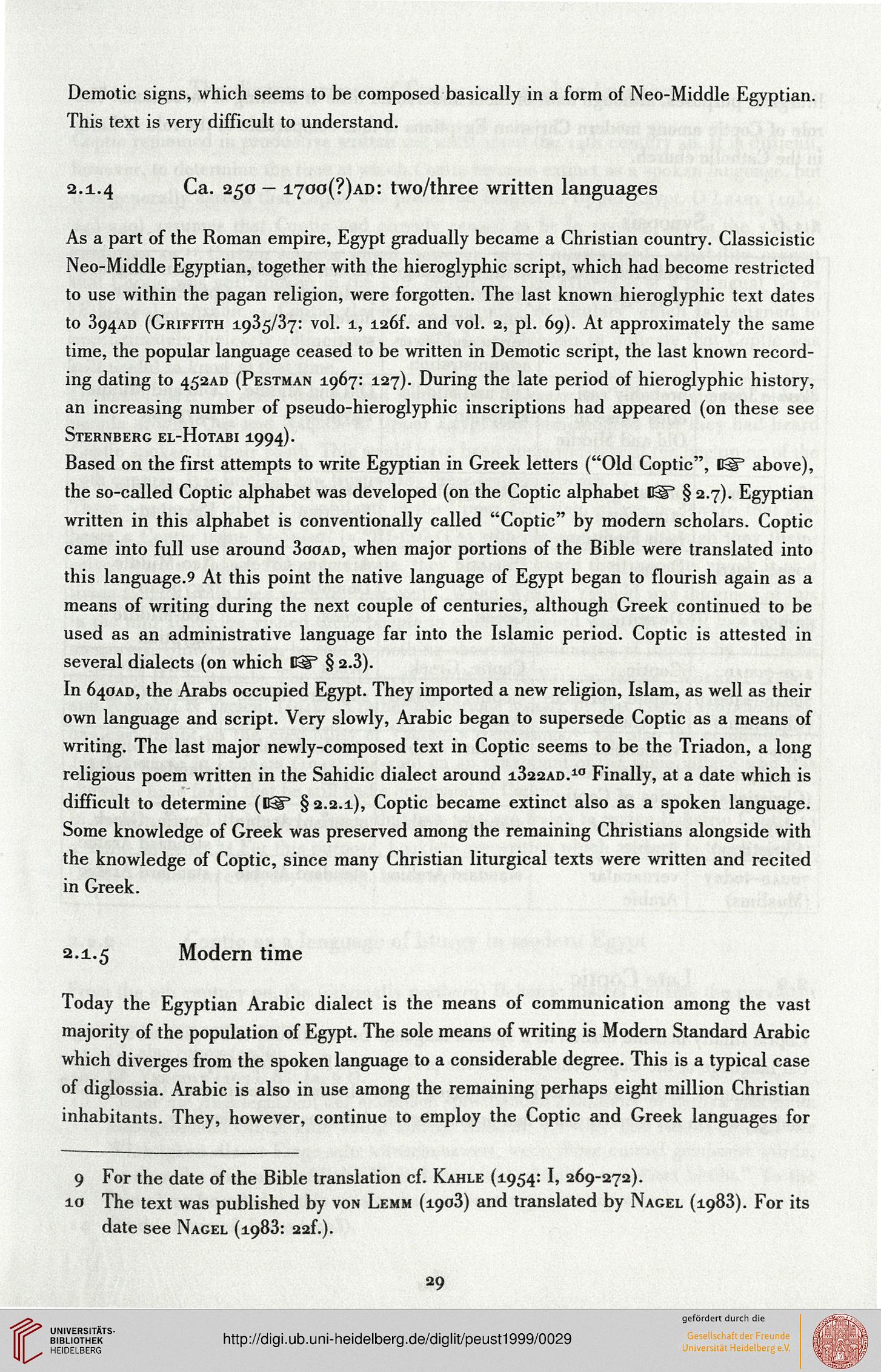Demotic signs, which seems to be composed basically in a form of Neo-Middle Egyptian.
This text is very difficult to understand.
2.1.4 Ca. 250 — 17go(?)ad: two/three written languages
As a part of the Roman empire, Egypt gradually became a Christian country. Classicistic
Neo-Middle Egyptian, together with the hieroglyphic script, which had become restricted
to use within the pagan religion, were forgotten. The last known hieroglyphic text dates
to 394AD (Griffith 1935/37: vol. 1, i26f. and vol. 2, pi. 69). At approximately the same
time, the popular language ceased to be written in Demotic script, the last known record-
ing dating to 452AD (Pestman 1967: 127). During the late period of hieroglyphic history,
an increasing number of pseudo-hieroglyphic inscriptions had appeared (on these see
Sternberg el-Hotabi 1994).
Based on the first attempts to write Egyptian in Greek letters ("Old Coptic", K§° above),
the so-called Coptic alphabet was developed (on the Coptic alphabet Eg" § 2.7). Egyptian
written in this alphabet is conventionally called "Coptic" by modern scholars. Coptic
came into full use around 3ooad, when major portions of the Bible were translated into
this language.9 At this point the native language of Egypt began to flourish again as a
means of writing during the next couple of centuries, although Greek continued to be
used as an administrative language far into the Islamic period. Coptic is attested in
several dialects (on which B3T § 2.3).
In 640AD, the Arabs occupied Egypt. They imported a new religion, Islam, as well as their
own language and script. Very slowly, Arabic began to supersede Coptic as a means of
writing. The last major newly-composed text in Coptic seems to be the Triadon, a long
religious poem written in the Sahidic dialect around i322ad.10 Finally, at a date which is
difficult to determine (03° §2.2.1), Coptic became extinct also as a spoken language.
Some knowledge of Greek was preserved among the remaining Christians alongside with
the knowledge of Coptic, since many Christian liturgical texts were written and recited
in Greek.
2.1.5 Modern time
Today the Egyptian Arabic dialect is the means of communication among the vast
majority of the population of Egypt. The sole means of writing is Modern Standard Arabic
which diverges from the spoken language to a considerable degree. This is a typical case
of diglossia. Arabic is also in use among the remaining perhaps eight million Christian
inhabitants. They, however, continue to employ the Coptic and Greek languages for
9 For the date of the Bible translation cf. Kahle (1954: I, 269-272).
10 The text was published by von Lemm (1903) and translated by Nagel (1983). For its
date see Nagel (1983: 22f.).
29
This text is very difficult to understand.
2.1.4 Ca. 250 — 17go(?)ad: two/three written languages
As a part of the Roman empire, Egypt gradually became a Christian country. Classicistic
Neo-Middle Egyptian, together with the hieroglyphic script, which had become restricted
to use within the pagan religion, were forgotten. The last known hieroglyphic text dates
to 394AD (Griffith 1935/37: vol. 1, i26f. and vol. 2, pi. 69). At approximately the same
time, the popular language ceased to be written in Demotic script, the last known record-
ing dating to 452AD (Pestman 1967: 127). During the late period of hieroglyphic history,
an increasing number of pseudo-hieroglyphic inscriptions had appeared (on these see
Sternberg el-Hotabi 1994).
Based on the first attempts to write Egyptian in Greek letters ("Old Coptic", K§° above),
the so-called Coptic alphabet was developed (on the Coptic alphabet Eg" § 2.7). Egyptian
written in this alphabet is conventionally called "Coptic" by modern scholars. Coptic
came into full use around 3ooad, when major portions of the Bible were translated into
this language.9 At this point the native language of Egypt began to flourish again as a
means of writing during the next couple of centuries, although Greek continued to be
used as an administrative language far into the Islamic period. Coptic is attested in
several dialects (on which B3T § 2.3).
In 640AD, the Arabs occupied Egypt. They imported a new religion, Islam, as well as their
own language and script. Very slowly, Arabic began to supersede Coptic as a means of
writing. The last major newly-composed text in Coptic seems to be the Triadon, a long
religious poem written in the Sahidic dialect around i322ad.10 Finally, at a date which is
difficult to determine (03° §2.2.1), Coptic became extinct also as a spoken language.
Some knowledge of Greek was preserved among the remaining Christians alongside with
the knowledge of Coptic, since many Christian liturgical texts were written and recited
in Greek.
2.1.5 Modern time
Today the Egyptian Arabic dialect is the means of communication among the vast
majority of the population of Egypt. The sole means of writing is Modern Standard Arabic
which diverges from the spoken language to a considerable degree. This is a typical case
of diglossia. Arabic is also in use among the remaining perhaps eight million Christian
inhabitants. They, however, continue to employ the Coptic and Greek languages for
9 For the date of the Bible translation cf. Kahle (1954: I, 269-272).
10 The text was published by von Lemm (1903) and translated by Nagel (1983). For its
date see Nagel (1983: 22f.).
29




